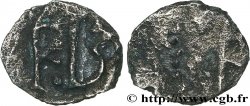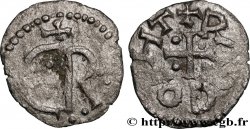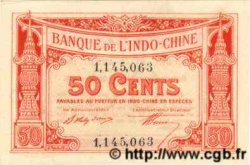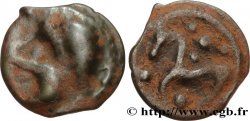Not available.
Item sold on our e-shop (2017)
Price : 400.00 €
Item sold on our e-shop (2017)
Price : 400.00 €
Type : Denier indéterminé
Date: VIIIe siècle
Mint name / Town : Limoges
Metal : silver
Diameter : 12,5 mm
Orientation dies : 10 h.
Weight : 0,87 g.
Rarity : R3
Coments on the condition:
Bel exemplaire homogène avec des types bien centrés et bien frappés
Catalogue references :
Obverse
Obverse legend : LÉGENDE INDÉTERMINÉE.
Obverse description : ER rétrogrades en plein champ avec des globules .
Reverse
Reverse legend : LÉGENDE INDÉTERMINÉE.
Reverse description : Croix ancrée dans un cordon perlé ; un globule dans chaque canton.
Commentary
Les lettres ER signifieraient Ecclesiae Racio. Ces deniers étaient classés de façon douteuse à Paris. D’Amécourt signale que ces monnaies ont été trouvées dans les dragages de la Loire. Cette série est désormais attribué à l’église de Limoges et à Neuvic-d’Ussel (B. 6340). Ces monnaies sont rares et leur classement reste limité (cf. Moneta p. 134).
Bien que les lettres ER du droit soient rétrogrades, il semble logique de rapprocher ce denier des autres avec les lettre ER à droite (cf.MONNAIES 55, n° 612, bmv_290401, bmv_329454 et bmv_424056). Il est d’ailleurs intéressant que si ces 5 deniers ont un avers très proche, tous les revers sont différents..
The letters ER would mean Ecclesiae Racio. These deniers were classified in a dubious manner in Paris. D'Amécourt reports that these coins were found in the dredging of the Loire. This series is now attributed to the church of Limoges and to Neuvic-d'Ussel (B. 6340). These coins are rare and their classification remains limited (cf. Moneta p. 134). Although the letters ER on the obverse are retrograde, it seems logical to bring this denier closer to the others with the letters ER on the right (cf. MONNAIES 55, no. 612, bmv_290401, bmv_329454 and bmv_424056). It is also interesting that if these 5 deniers have a very similar obverse, all the reverses are different.
Bien que les lettres ER du droit soient rétrogrades, il semble logique de rapprocher ce denier des autres avec les lettre ER à droite (cf.MONNAIES 55, n° 612, bmv_290401, bmv_329454 et bmv_424056). Il est d’ailleurs intéressant que si ces 5 deniers ont un avers très proche, tous les revers sont différents..
The letters ER would mean Ecclesiae Racio. These deniers were classified in a dubious manner in Paris. D'Amécourt reports that these coins were found in the dredging of the Loire. This series is now attributed to the church of Limoges and to Neuvic-d'Ussel (B. 6340). These coins are rare and their classification remains limited (cf. Moneta p. 134). Although the letters ER on the obverse are retrograde, it seems logical to bring this denier closer to the others with the letters ER on the right (cf. MONNAIES 55, no. 612, bmv_290401, bmv_329454 and bmv_424056). It is also interesting that if these 5 deniers have a very similar obverse, all the reverses are different.








 Report a mistake
Report a mistake Print the page
Print the page Share my selection
Share my selection Ask a question
Ask a question Consign / sell
Consign / sell
 Full data
Full data











